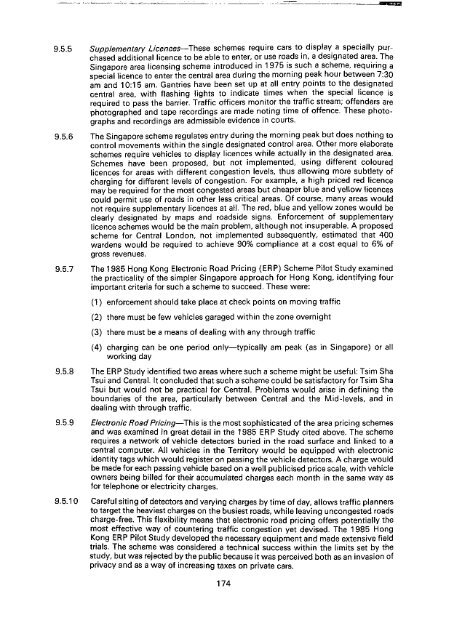Untitled - HKU Libraries - The University of Hong Kong
Untitled - HKU Libraries - The University of Hong Kong
Untitled - HKU Libraries - The University of Hong Kong
- No tags were found...
Create successful ePaper yourself
Turn your PDF publications into a flip-book with our unique Google optimized e-Paper software.
9.5.5 Supplementary Licences—<strong>The</strong>se schemes require cars to display a specially purchasedadditional licence to be able to enter, or use roads in, a designated area. <strong>The</strong>Singapore area licensing scheme introduced in 1975 is such a scheme, requiring aspecial licence to enter the central area during the morning peak hour between 7:30am and 10:15 am. Gantries have been set up at all entry points to the designatedcentral area, with flashing lights to indicate times when the special licence isrequired to pass the barrier. Traffic <strong>of</strong>ficers monitor the traffic stream; <strong>of</strong>fenders arephotographed and tape recordings are made noting time <strong>of</strong> <strong>of</strong>fence. <strong>The</strong>se photographsand recordings are admissible evidence in courts.9.5.6 <strong>The</strong> Singapore scheme regulates entry during the morning peak but does nothing tocontrol movements within the single designated control area. Other more elaborateschemes require vehicles to display licences while actually in the designated area.Schemes have been proposed, but not implemented, using different colouredlicences for areas with different congestion levels, thus allowing more subtlety <strong>of</strong>charging for different levels <strong>of</strong> congestion. For example, a high priced red licencemay be required for the most congested areas but cheaper blue and yellow licencescould permit use <strong>of</strong> roads in other less critical areas. Of course, many areas wouldnot require supplementary licences at all. <strong>The</strong> red, blue and yellow zones would beclearly designated by maps and roadside signs. Enforcement <strong>of</strong> supplementarylicence schemes would be the main problem, although not insuperable. A proposedscheme for Central London, not implemented subsequently, estimated that 400wardens would be required to achieve 90% compliance at a cost equal to 6% <strong>of</strong>gross revenues.9.5.7 <strong>The</strong> 1985 <strong>Hong</strong> <strong>Kong</strong> Electronic Road Pricing (ERP) Scheme Pilot Study examinedthe practicality <strong>of</strong> the simpler Singapore approach for <strong>Hong</strong> <strong>Kong</strong>, identifying fourimportant criteria for such a scheme to succeed. <strong>The</strong>se were:(1) enforcement should take place at check points on moving traffic(2) there must be few vehicles garaged within the zone overnight(3) there must be a means <strong>of</strong> dealing with any through traffic(4) charging can be one period only—typically am peak (as in Singapore) or allworking day9.5.8 <strong>The</strong> ERP Study identified two areas where such a scheme might be useful: Tsim ShaTsui and Central. It concluded that such a scheme could be satisfactory for Tsim ShaTsui but would not be practical for Central. Problems would arise in defining theboundaries <strong>of</strong> the area, particularly between Central and the Mid-levels, and indealing with through traffic.9.5.9 Electronic Road Pricing—This is the most sophisticated <strong>of</strong> the area pricing schemesand was examined in great detail in the 1985 ERP Study cited above. <strong>The</strong> schemerequires a network <strong>of</strong> vehicle detectors buried in the road surface and linked to acentral computer. All vehicles in the Territory would be equipped with electronicidentity tags which would register on passing the vehicle detectors. A charge wouldbe made for each passing vehicle based on a well publicised price scale, with vehicleowners being billed for their accumulated charges each month in the same way asfor telephone or electricity charges.9.5.10 Careful siting <strong>of</strong> detectors and varying charges by time <strong>of</strong> day, allows traffic plannersto target the heaviest charges on the busiest roads, while leaving uncongested roadscharge-free. This flexibility means that electronic road pricing <strong>of</strong>fers potentially themost effective way <strong>of</strong> countering traffic congestion yet devised. <strong>The</strong> 1985 <strong>Hong</strong><strong>Kong</strong> ERP Pilot Study developed the necessary equipment and made extensive fieldtrials. <strong>The</strong> scheme was considered a technical success within the limits set by thestudy, but was rejected by the public because it was perceived both as an invasion <strong>of</strong>privacy and as a way <strong>of</strong> increasing taxes on private cars.174
















